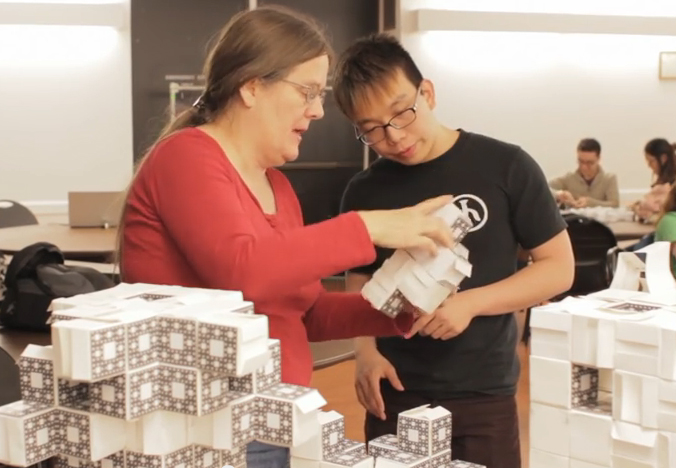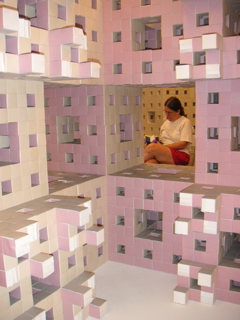What Has Zero Volume but Infinite Surface Area?
-
-
slice.mit.edu
- 2
Filed Under
Recommended

A Menger Sponge is the answer. MIT's origami team, OrigaMIT, which made one out of 50,000 business cards, defines it as a mathematical fractal formed by iteratively removing the middle cross-sections of a cube. Their effort is special because it helped complete an international effort to recreate a Megamenger and because the level-3 version was first designed and built by origami artist Jeannine Mosely SM ’79, EE ’80, PhD ’84.
Watch a video about their project, completing a level-3 Menger sponge—that measured ~54 inches to each side—thanks to the help of Mosely and the students, faculty, and staff who stopped by to fold last fall.
So what was Mosely’s role in constructing the level-3 Menger Sponge?
Mosely learned how to fold modular origami cubes out of business cards in 1994 from a verbal description in an email. Most modular origami designs involve tucking flaps into pockets in order to the link the units together, but the business card cube has only flaps and no pockets and is stable only when all of the flaps are on the outside of the model, she says. Then she had an insight while watching her seven-year-old son make and play with cubes.
“I realized that the corners of the flaps could be tucked under each other to link the cubes together. So you could build any shape you could imagine out of enough of them. I also observed that you could use the same unit to cover the flaps on the external faces of your model, to add pattern or color to the surface.”
By gathering obsolete business cards from colleagues, Mosely accumulated several hundred thousand cards. Then she decided to build a level-3 approximation of a Menger Sponge, a fractal shape named for its discoverer, Karl Menger. It’s an approximate rendering because a true fractal has an infinitesimal degree of detail, she says.

She estimated the project would require about 66,000 cards and take 800 person-hours to build. It took much longer.
“I decided to build it as a group project so that I could spread the joy of origami, math, and engineering around and get help building it. I taught classes and workshops at various schools, the MIT Museum, the Boston Science Museum, at origami conventions and festivals, always collecting cubes and larger modules for the finished sponge.”
Even then, with raising two children and working full time, the project took from 1994 to 2005.
Why do business cards work so well for this type of origami? The size, shape, and stiffness work well for three-dimensional projects. And they are easy to fold.
“The ratio of the sides of an American business card is 1.75:1. But 1.75 is very close to the square root of 3 (1.732) which is the arctangent of 60 degrees. This means that it is very easy to fold equilateral triangles in a business card. Just fold two opposite corners to touch each other and you will see what I mean. There are dozens of things you can do with equilateral triangles.”
Dr. Mosely’s current work as an origami artist includes the creation in 2008 of a model of the Worcester’s Union Station, with 300 local school children and 100 Worcester Polytechnic Institute students, in time for the New Year's Eve celebration. The train station incorporated around 60,000 business cards and was 10' wide, 7' deep and 6' tall.
Learn more about Jeannine Mosely and about paperfolding at MIT








Comments
Oona Houlihan
Thu, 04/30/2015 1:12pm
Visiting the site you linked to they are now at level 4. I would have never thought that anywhere and anyone in the world would dedicate from 1994 to 2005 and beyond in time plus the enormous amount of space to such a project. My only concern now would be that sometime this space would have to be reclaimed under some "utilitarian" excuse and since you cannot transport this "thing" unless you tear out some walls (and then I suspect it might fold under any aerial turbulence), this has to stay put, hasn't it? Will there be enough financial support? After all ... most works of art (and this should be classified as one) have enormous material value after some time, and certainly this is absolutely unique.
george stimmel
Thu, 04/02/2015 11:35pm
D*mn! I never thought of how complicated a simple question could get. I immediately thought of a plane, it also has infinite surface area and zero volume. I guess I should have taken Complication, C101, but I didn't even know it was offered. Maybe it wasn't even offered in 1960, in those days we were looking for the simplest solutions to complicated problems, not the most complicated solutions to simple problems.
Science has really changed during my lifetime.